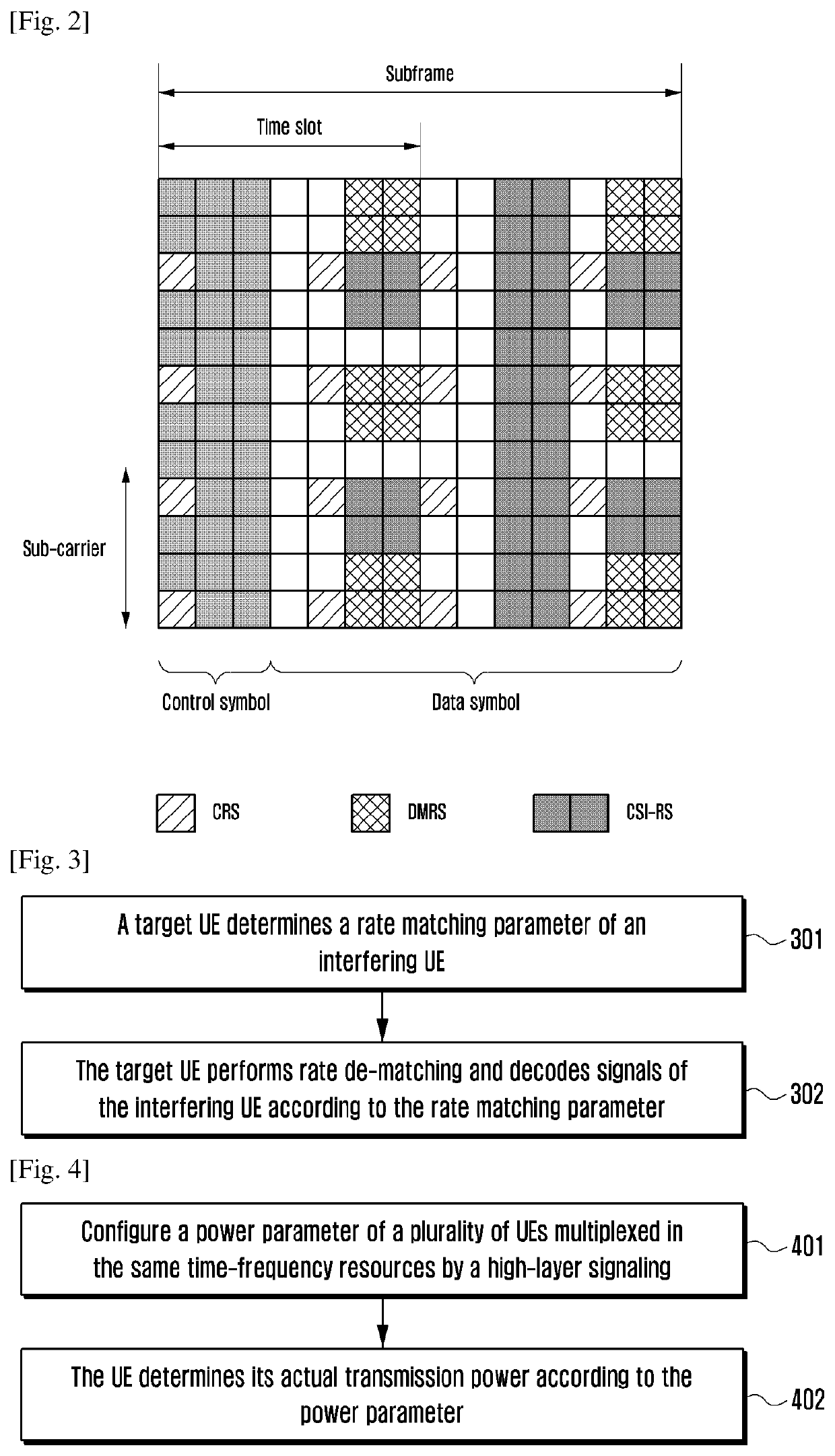Multi-user data transmission method and device
a data transmission and multi-user technology, applied in the field of wireless communication systems, can solve problems such as the effective support of multi-user multiplexing, and achieve the effect of optimizing system performan
- Summary
- Abstract
- Description
- Claims
- Application Information
AI Technical Summary
Benefits of technology
Problems solved by technology
Method used
Image
Examples
embodiment 1
[0067]According to the above analysis, in order to support the decoding of the interfering UE, the target UE needs to know a series of control information of the interfering UE. This control information can be a parameter indicating that rate matching is performed for data transmission of the interfering UE. According to the LTE standard, the size of soft buffer allocated to one transport block (TB) is represented by NIR, and the size of soft buffer of each code block divided from the TB is represented by Ncb, then
[0068]Ncb=min(⌊NIRC⌋,Kw),
where C is the total number of code blocks divided from the TB, and Kw is the total number of coding bits output by Turbo coding. If Ncbw, the soft buffer size allocated to one code block can be less than the total number of coding bits output by Turbo coding, referred to as a limited buffer rate matching (LBRM).
[0069]NIR=⌊NsoftKC·KMIMO·min(MDL_HARQ,Mlimit)⌋
where, Nsoft is the total number of soft buffer bits of the UE; KMIMO is determined accord...
embodiment 2
[0080]According to the above analysis, in order to support the decoding of the interfering UE, the target UE needs to know a series of control information of the interfering UE. This control information can be a parameter related to the MIMO transmission of the interfering UE. For a TM based on CRS demodulation, the target UE needs to know the number of layers of the interfering UE and the PMI; and for the TM based on DRMS demodulation, the target UE needs to know the number of layers of the interfering UE, and further, the DMRS port information of the interfering UE. The number of layers of the target UE is represented by K1, the number of layers of the interfering UE is represented by K2, and it is assumed that the pre-coding vectors in K≤min(K1,K2) layers of the two UEs are correspondingly equal.
[0081]When information about the interfering UE is indicated, information about only above K layers where pre-coding vectors are correspondingly equal can be indicated, including the numb...
embodiment 3
[0083]According to the above analysis, in order to support the decoding of the interfering UE, the target UE needs to know a series of control information of the interfering UE. This control information can be a power parameter of the interfering UE. In addition, the indication method of the power parameter is related to the number of layers of the UEs multiplexed in the same time-frequency resources.
[0084]One method is to indicate the signal power of the target UE and the signal power of the interfering UE, respectively. This information can be semi-statically indicated by a high-layer signaling or dynamically indicated by the DCI. This power parameter can be the total power of signals of each layer of one UE. That is, the total signal power of the target UE and the total signal power of the interfering UE are configured, respectively. Or, this power parameter can be the power of one layer of the UE. That is, only the power of one layer of the target UE and the power of one layer o...
PUM
 Login to View More
Login to View More Abstract
Description
Claims
Application Information
 Login to View More
Login to View More - R&D
- Intellectual Property
- Life Sciences
- Materials
- Tech Scout
- Unparalleled Data Quality
- Higher Quality Content
- 60% Fewer Hallucinations
Browse by: Latest US Patents, China's latest patents, Technical Efficacy Thesaurus, Application Domain, Technology Topic, Popular Technical Reports.
© 2025 PatSnap. All rights reserved.Legal|Privacy policy|Modern Slavery Act Transparency Statement|Sitemap|About US| Contact US: help@patsnap.com



